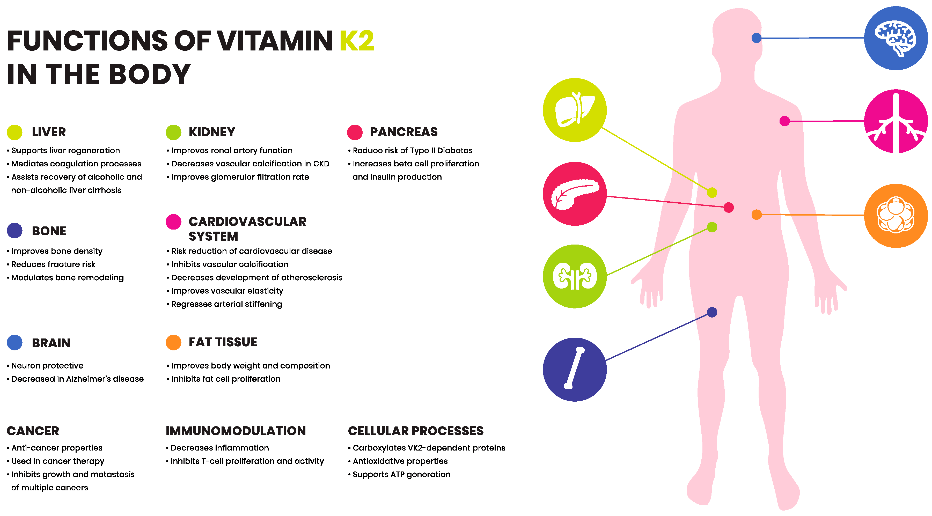 Vitamin K is an essential bioactive compound required for optimal body function. Vitamin K can be present in various isoforms, distinguishable by two main structures, namely, phylloquinone (K1) and menaquinones (K2). The difference in structure between K1 and K2 is seen in different absorption rates, tissue distribution, and bioavailability. With K2 being better absorbed than K1.
Vitamin K is an essential bioactive compound required for optimal body function. Vitamin K can be present in various isoforms, distinguishable by two main structures, namely, phylloquinone (K1) and menaquinones (K2). The difference in structure between K1 and K2 is seen in different absorption rates, tissue distribution, and bioavailability. With K2 being better absorbed than K1.
Vitamin K was discovered in 1929 by the Danish biochemist Henrik Dam during his experiments on cholesterol metabolism in chickens. When fed low-fat diets, chickens experienced prolonged clotting time and haemorrhage, which surprisingly could not be rescued when diet was enriched with cholesterol. Dam assumed a deficiency of a vitamin required for coagulation, which he termed “Koagulation vitamin,” hence vitamin K.
The main source of vitamin K1 in the diet is green vegetables, whereas vitamin K2 can be found in fermented foods such as soybeans, cheese, and sauerkraut. The richest source of vitamin K2 (MK-7) is a Japanese dish named Natto, which is produced from fermented soybeans with aid of the Bacillus Subtilis bacteria strain. In addition to nutritional consumption, gut bacteria Lactococcus and Escherischia coli are able to synthesise long chain menaquinones and may provide some Vit K2 but most is retained in their cell walls and is not available to us.
Although differing in structure, both act as cofactor for the enzyme gamma-glutamylcarboxylase, encompassing both hepatic and extrahepatic activity. Only carboxylated proteins are active and promote a health profile like haemostasis. Furthermore, vitamin K2 in the form of MK-7 has been shown to be an important bioactive compound in regulating osteoporosis, atherosclerosis, cancer and inflammatory diseases without risk of negative side effects or overdosing.
For example, turning on proteins in the body vitamin K activates the calcium binding actions of two – matrix GLA protein and Osteocalcin, which drives calcium out of the arteries and into the bones.
 Differences between Vitamins K1 and K2
Differences between Vitamins K1 and K2
A large epidemiological study back in 2004 from the Netherlands illustrates the clinical differences well. Researchers for this study collected data on the vitamin K intakes of the subjects between 1990 and 1993. They measured the extent of heart disease in each subject, who had died from it, and how this related to K2 intake and arterial calcification. They found that calcification of the arteries which can cause blood vessels to narrow was the best predictor of heart disease. Those in the highest third of K2 intakes were:
- 52% less likely to develop severe calcification of the arteries
- 41% less likely to develop heart disease
- 57% less likely to die from it
However, intake of vitamin K1 had no effect on participants’ heart health.
A further paper from 2014 explored 7,216 participants from the PREDIMED study using prospective cohort analysis and concluded; an increase in dietary intake of vitamin K is associated with a reduced risk of cardiovascular, cancer, or all-cause mortality in a Mediterranean population at high cardiovascular disease risk.
Trends in research relating to Vitamin K and in particular K2, much like the early pattern in vitamin D3 are helping to further indicate that low levels of Vit K2 is a modifiable risk factor in a number of age related changes in health and suggests that as the risk profile for consumption via supplementation of K2 is negligible versus the significant risks associated with a deficiency that oral supplementation as well as increased food intake is a sensible health management approach.
The additional intake of the combination of vitamin D, A and E which also confer multiple health advantages may be considered a clinically prudent combination.
Functions of vitamin K2 in the body; Vitamin K2 exerts protective role and is involved in various organ systems throughout the human body (summarised in the figure).

